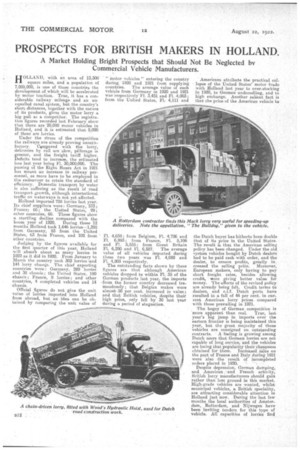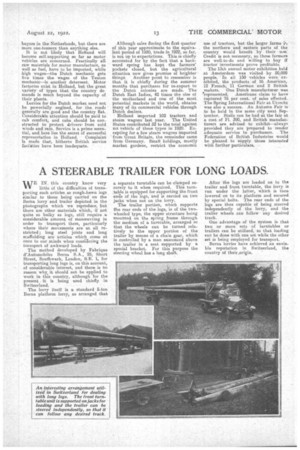PROSPECTS FOR BRITISH MAKERS IN HOLLAND,
Page 12

Page 13

If you've noticed an error in this article please click here to report it so we can fix it.
A Market Holding Bright Prospects that Should Not Be Neglected by Commercial Vehicle Manufacturers.
OMANI), with an area of 12.500 square miles, and a population of 7,000,000, is one of those countries the development of which will be accelerated by motor traction. True, it has a considerable railway mileage and an unequalled canal system, but, the country's short dista,nces, together with the nature of its produets, gives the motor lorry a big pull as a competitor. The registration figures recorded last February show that there are 20,000 motor vehicles in Holland, and it is estimated that 5000 of these are lorries.
Under the stress of the competition the railways are already proving unsatisfactory. Campared with the lorry, deliveries by rail are .slow, pilferage is greater, and the freight tariff higher. Deficit; tend to increase, the estimated loss last year being Fl. 30,000;000. The passing of the Eight Hours Act in 1921 has meant an increase in railway personnel, as more have to 'be employed in the endeavour to retain the standard of efficiency. Domestic transport by water is also suffering as the result of road transport growth, although international traffic on waterways is not yet affected.
Holland imported 728 lorries last year. Its chief suppliers were: Germany, 573; France; 66; the United States, 29; other countries, 60. These figures show a startling decline compared with the boom year of 1920. During these 12 months Holland took 1,646 lorries-1,398 from Germany, 83 from the United States, 63 from France, and 102 from other countries.
Judging by the figures available for the first quarter of this year' Holland will absorb about as many lorries in 1922 as it did in 1920. From January to March the country took 302 lorries and 144 lorry chassis. The chief exporting countries were: Germany, 289 lorries and 30 chassis ; the United States, 100 chassis ; France, 9 lorries; and other countries, 4 completed vehicles and 14 chassis.
Official figures do not, give the unit value of lorries imported into Holland from abroad, but an idea can be obtained by comparing the unit value of " motor vehicles " entering the country during 1920 and 1921 from supplying countries. The average value of each vehicle from Germany in 1920 and 1921 was respectively Fl, 3,451 and Fl. 4,003; from the United States, Fl. 4,111 and Fl. 4,038; from Belgium, Fl. 4,726 and Fl. 6,993; from France, Fl. 5,106 and Fl. 5,555; from Great Britain Fl. 6,280 and Fl. 6,587. The average value of all vehicles imported during these two years was Fl. 4,089 and Fl. 4,803 respectively. The outstanding facts shown by these figures are that although American vehicles dropped to within Fl. 35 of the German products last year, the imports -from the former country decreased tremendously; that Belgian makes were almost-50 _per cent, increased in value; and that British vehicles, despite their high price, only fell by 30 last year during a period of stagnation. Americans attribute the practical collapse of the United States' motor trade with Holland last year to over-stocking in 1920, to German underselling, and to high exchange. Another salient fact is that the price of the American vehicle to the Dutch buyer has hitherto been double that of its price in the United States. The result is that. the American selling policy has been changed. Under the old system vehicles bought by Dutch dealers had to be paid cash with order, and the dealer, to ensure profits, greatly in,
creased the selling priCe. Moreover, European makers, only having to pay short freight rates, besides allowing credit, were giving better value for money. The effects of the revised policy are already being felt. Credit terms to dealers, and c.i.f. Dutch ports have resulted in a fall of 44 per cent. in .current American lorry prices compared with those prevailing in 1921.
. The bogey of German competition is more apparent than real. True, last year's big jump in imports over the eastern frontier is being maintained this year, but the great majority of these vehicles are consigned On outstanding contracts. A feeling is growing among Dutch users that German lorries are not capable of long service; and the vehicles are losing that popularity their cheapness obtained for them. 1mi-eased. sales on the part of France and Italy during 1921 were also the result, of incompleted orders placed in 1920.
Despite depression, German dumping, and American . and French activity, British lorry manufacturers should gain rather than lose ground in this market. High-grade vehicles are wanted, whilst municipal vehicles, a, British speciality, are attracting considerable attention in Holland just now. During the last few months the local authorities of Amsterdam,. Rotterdam, and Nijwegen have been inviting tenders for this type of vehicle. All capacities of lorries find
buyers in the Netherlands, but there are more one-tonners than anything else.
It is not likely that Holland will become self-supporting so far as motor vehicles are concerned. Practically all raw materials for motor manufacture, as well as fuel, have to be imported, while high wages—the Dutch mechanic gets five times the wages of the Teuton mechanic—is another deterrent. Motor factories exist in Holland, but the great variety of types that the country demands is much beyond the capacity of their plants. Lorries for the Dutch market need not be powerfully engined, for the roads generally are good and the country fiat. Considerable attention should be paid to cab comfort, and cabs should be constructed to protect drivers' from cold winds and rain. Service is a prime essential, and here lies the secret of successful representation in Holland. Complaint is made that, hitherto British service fad:idles have been inadequate. Although sales during the first quarter of this year approximate to the equivalent period of 1920, trade in 1922, so far, is not up to expectations. This is chiefly accounted for by the fact. that a backward spring has kept the farmers' pockets closed, but the agricultural situation now gives promise of brighter things. " Another point to remember is that it is chiefly during the summer months that purchases for re-export to the Dutch colonies are made. The Dutch East Indies, 42 times the size ot the motherland and one cif the most potential markets in the world, obtains many of its commercial vehicles through Dutch dealers.
Holland imported 102 tractors and steam wagons last year. The -United States contributed 52 to the total against no, vehicle of these types in 1920. Excepting for a few steam wagons imported from Great Britain, the remainder came from Germany. Small holdings, mostly market gardens, restrict the economic use of tractors, but the larger farms the northern and eastern parts of the country Would benefit by their .use. i
Credit s not necessary, as these farmers are well-to-do and willing to buy if tractor" investments prove profitable.
The 13th annual motor exhibition held at Amsterdam was visited by 50,000 people. . In all 150 vehicles were exhibited, the products of 16 American, 12 French, 11 German and 2 British makers. One Dutch manufacturer was .represented. Americans claim to have Captured 75 per cent, of sales effected. The Spring International Fair at Utrecht was also a success. An Autumn Fair is to be held in the same city next September. Stalls can be had at the fair at a cost of Ft. 390, and British manufacturers are advised to exhibit—alwayi provided they are prepared to render adequate service to purchasers. . The Federation of British Industries would be pleased to supply those interested with further particulars.


































